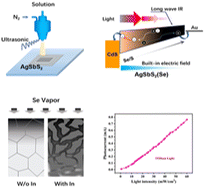Ultrafast and broadband photodetection based on selenized AgSbS2 thin films prepared by spray pyrolysis deposition and modified with indium nitrate†
Abstract
Silver antimony sulfide (AgSbS2) stands out as a promising absorber material for optoelectronic devices, thanks to its exceptional optical properties, solution processability, and versatile composition tunability. However, its practical application in long-wave photodetection is hindered by the relatively large band gap (∼1.7 eV). While selenization can reduce the band gap, its effectiveness is often limited by the compact crystal grain structure, especially in thick films, leading to an insufficient selenization rate. Consequently, photodetectors based on selenized AgSbS2 exhibit minimal response to infrared radiation. To address this challenge, we propose a novel approach: constructing a porous AgSbS2 precursor by incorporating higher solubility indium nitrate into the spray solution. We have developed a model that considers the crystallization aspect to explain the formation of this porous morphology and crystal structure. The resulting AgSbS2(Se) photodetectors exhibit a broadband response range extending beyond 1920 nm and a high bandwidth of up to 0.3 MHz, owing to the special gradient structure with a high selenization rate. These outstanding features suggest great potential for application in high-speed photon computation and communication systems. Moreover, it opens up new possibilities for developing high-performance broadband photodetectors by reconstructing existing compound semiconductors.



 Please wait while we load your content...
Please wait while we load your content...